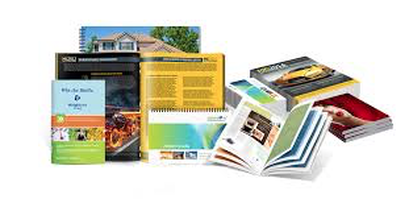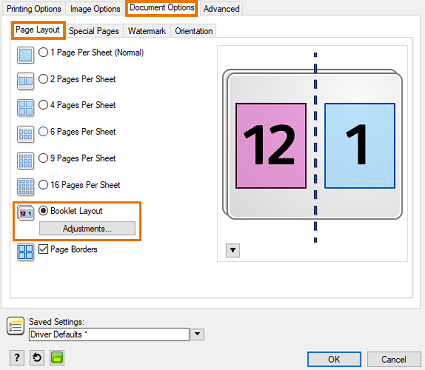The Crucial Guide to Comprehending Booklet Printing Options and Techniques
The process of pamphlet printing involves multiple factors to consider that can greatly impact the end product. From selecting the appropriate format and dimension to recognizing the subtleties of binding methods, each choice plays an important duty. In addition, aspects such as paper supply and printing techniques additional affect the effectiveness of the booklet. As one navigates these alternatives, it ends up being vital to realize how they interconnect and what that suggests for the total result.
Understanding Pamphlet Formats and Dimensions
When taking into consideration pamphlet printing, comprehending the various layouts and dimensions offered is essential for achieving the wanted discussion. Brochures can be created in countless layouts, including saddle-stitched, spiral-bound, and perfect-bound, each offering distinctive advantages. Typical dimensions range from basic letter (8.5 x 11 inches) to smaller sized alternatives like A5 (5.8 x 8.3 inches), allowing for adaptability based upon web content and target audience.Selecting the appropriate dimension can affect both the layout and visitor interaction. Larger dimensions might suit visually driven material, while smaller sized layouts may be much more user-friendly and mobile. Furthermore, the number of pages impacts the choice of binding approach, as thicker booklets may call for stronger bindings. Ultimately, understanding these aspects permits an extra customized technique, making certain that the end product lines up with the designated message and aesthetic, improving the overall efficiency of the interaction.
Picking the Right Paper Stock

Binding Techniques: Options and Considerations
When it pertains to binding techniques for pamphlets, several choices are available, each with unique benefits. Saddle stitch binding offers a cost-efficient solution for thinner booklets, while ideal binding techniques offer an even more sleek appearance for thicker magazines. Wire-O binding sticks out for its toughness and convenience of usage, making it optimal for papers that need flexibility.
Saddle Stitch Binding
Saddle stitch binding supplies a practical and cost-effective option for setting up pamphlets, making it a popular choice amongst services and publishers. This binding approach involves folding sheets of paper in half and stapling them along the fold line, developing a orderly and cool look. Generally suitable for pamphlets with a lower page count, saddle sewing is ideal for publications, sales brochures, and training materials. The simpleness of this method enables fast manufacturing and is commonly preferred for brief runs or marketing products. It is vital to note that saddle stitch binding might not be appropriate for thicker booklets, as the spine may not hold up under raised weight. On the whole, it remains a reputable option for several printing projects.
Perfect Binding Techniques
Perfect binding is an extensively made use of technique that provides a specialist and polished coating to publications and pamphlets. This method includes gluing the pages with each other at the spine making use of a solid adhesive, permitting a clean side and the capacity to hold a bigger variety of pages compared to saddle stitching. Perfect binding is especially appropriate for thicker pamphlets, such as magazines and yearly reports, where a sturdy, flat back is preferred. Additionally, it uses the alternative for a published cover that can be designed to improve visual allure. Considerations such as web page count, paper weight, and the meant use of the brochure should be taken into account, as they can influence sturdiness and general quality.
Wire-O Binding Alternatives
Wire-O binding, known for its durability and versatility, uses an outstanding choice for pamphlets that call for very easy page transforming and an expert look. This binding technique employs a series of steel loops that hold web pages securely, enabling them to exist level when open. It is particularly ideal for magazines, guidebooks, and discussions because of its robust nature. Wire-O binding is available in numerous shades and diameters, fitting various web page matters and densities. In addition, it allows the incorporation of tabs and covers, boosting the pamphlet's general visual. Factors to consider for Wire-O binding include the option of cable color, the size of the loopholes, and the level of customization wanted, every one of which can greatly affect the last item's appearance and performance.
Digital vs. Offset Printing: Which Is Best for You?
When choosing a printing method for brochures, recognizing the differences between digital and balance out printing is crucial. Digital printing uses contemporary innovation to create premium prints rapidly and affordably, making it ideal for brief runs or tasks requiring quick turn-around times. It permits modification, offering the ability to publish on-demand with minimal waste.In contrast, counter printing is a standard method that excels in creating large quantities with regular top quality. It involves transferring ink from a plate to a rubber covering, then to the paper, which causes precise details and lively shades. Nonetheless, counter printing usually requires longer arrangement times and is a lot more cost-effective for bigger volumes.Ultimately, the choice in between electronic and balance out printing relies on job requirements, spending plan, and preferred amount. For small, time-sensitive jobs, electronic could be the ideal choice, while offset might be more effective for bigger, top quality productions.

Designing Your Brochure: Tips and Best Practices
When designing a brochure, careful attention to format, font option, and shade usage can substantially enhance its efficiency. A well-structured layout overviews the viewers's eye, while appropriate fonts ensure readability and share the wanted tone. In addition, reliable use color can evoke feelings and highlight crucial information, making the general style much more impactful.
Choosing the Right Format
Exactly how can one effectively select the best format for a pamphlet? First, it is necessary to evaluate the brochure's function and target audience. A clean, arranged format boosts readability and involvement. Using a grid system can assist in lining up elements constantly, developing a professional appearance. Furthermore, integrating aesthetic pecking order through differing sizes and placements of pictures and message can assist the visitor's eye and stress essential details. It is more helpful hints also essential to leave adequate white area, which protects against overcrowding and enables much better emphasis. Finally, testing various formats via mock-ups can supply understanding right into how the style executes in real-world situations, making sure that the end product satisfies both functional and visual requirements.
Picking Suitable Font Styles
A well-chosen font can considerably boost the overall design of a booklet, complementing the design and enhancing the web content's message. The option of typefaces must consider readability, specifically for body text, as it assures the info is accessible to all visitors. Sans-serif fonts are commonly preferred for digital layouts, while serif typefaces can lend a standard feeling in printed materials. It's suggested to limit font options to two or 3 to maintain visual comprehensibility. In addition, typeface dimension plays an important duty; headings ought to be unique but not frustrating, while body message must be comfortable for analysis. When picking typefaces, positioning with the booklet's motif and target audience is important for efficient communication and visual charm.
Effective Use Shade
Shade acts as an effective tool in pamphlet design, forming understandings and directing reader emotions. It can evoke feelings of calmness, exhilaration, or trust fund, depending on the shades picked. Developers should think about shade theory principles, making sure that the picked palette lines up with the brochure's message and target market. Using warm colors like red and orange can develop seriousness, while cooler tones like blue and environment-friendly foster tranquility.Additionally, comparison plays an essential duty; complementary shades can improve readability and aesthetic charm. Uniformity in shade usage throughout web pages better strengthens brand name identification and communication. Inevitably, efficient shade execution not just catches interest however likewise enhances the booklet's objective, making it an important element of successful style.
Ending Up Touches: Coatings and Special Impacts
While numerous consider the content and format of a pamphlet one of the most important components, the completing touches, such as finishings and special results, play a crucial duty in improving its general charm. Coatings can provide defense and longevity, making sure that the brochure stands up to wear and tear. Matte coatings use a sophisticated, non-reflective surface area, while shiny layers can make shades appear even more lively and captivating. Special results, like embossing or foil marking, include a tactile measurement that can create a memorable impact. These methods can highlight specific locations, drawing interest to important info or creating aesthetic rate of interest. In addition, UV covering can supply a high-shine coating that raises the total look.Together, these finishing touches not only boost the pamphlet's visual however also communicate expertise and interest to information, ultimately leaving an enduring influence on the viewers.
Expense Factors To Consider for Booklet Printing
Comprehending the numerous cost considerations for booklet printing is vital for organizations and services intending to optimize their budgets. Secret aspects influencing prices include the choice of ink, binding, and paper methods. Better products, such as premium paper or specialized inks, usually boost the general expenditure. In addition, the dimension and web page count of the booklet play a considerable role; larger booklets require more resources and time to produce.Another essential consideration is the printing technique, whether digital or offset, as each has its own pricing structure and suitability for different amounts. Companies ought to likewise factor in design costs, which can vary based upon intricacy and making use of specialist solutions. Inevitably, delivery and handling charges can include in the total, especially for large orders. By evaluating these elements, companies can make enlightened choices that align with their financial capacities while attaining the preferred high quality in their printed products.
Regularly Asked Questions
What Are the Ecological Effects of Pamphlet Printing?
The ecological effects of booklet printing include logging from paper manufacturing, carbon emissions from transportation, and waste generation from disposed of products - Booklet Printing. Lasting techniques, such as making use of recycled paper and environmentally friendly inks, can alleviate these impacts
Just How Can I Make Certain Shade Precision in My Pamphlet?
To assure shade precision in a brochure, one should make use of calibrated monitors, utilize professional color accounts, carry out test prints, and pick premium printing services that use color Recommended Reading matching and proofing alternatives for finest outcomes.
What Is the Regular Turnaround Time for Pamphlet Printing?
The common turn-around time for booklet printing differs depending upon the complexity and amount - Booklet Printing. Usually, it varies from a couple of days to two weeks, affected by factors such as publishing methods and completing requirements
Exist Minimum Order Quantities for Brochure Printing?

Can I Publish Pamphlets in Numerous Languages?
Printing brochures in numerous languages is feasible. Lots of printing services offer choices for multilingual or multilingual designs, permitting reliable interaction. Mindful preparation warranties that design elements accommodate various languages without endangering readability or visual appeals. Furthermore, aspects such as paper supply and printing methods additional influence the efficiency of the booklet. When thinking about brochure printing, comprehending the different formats and sizes available is see this page important for attaining the desired presentation. When choosing a printing approach for pamphlets, understanding the differences in between electronic and offset printing is important. Furthermore, the dimension and web page matter of the booklet play a significant duty; bigger brochures require even more sources and time to produce.Another crucial factor to consider is the printing strategy, whether digital or offset, as each has its very own prices structure and viability for various quantities. The environmental influences of brochure printing include logging from paper production, carbon emissions from transport, and waste generation from thrown out materials.